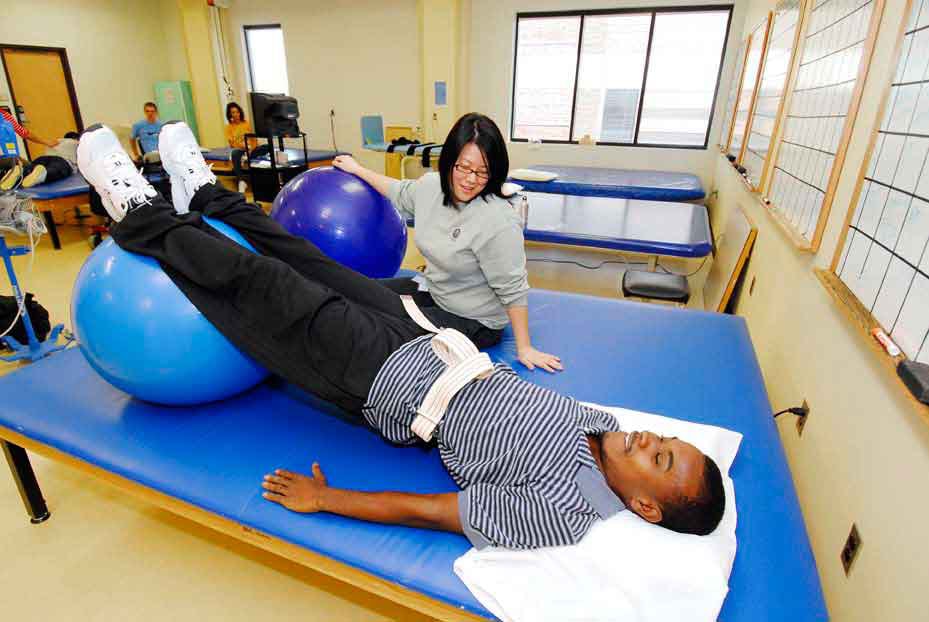
Welcome to the Topic “Spinal cord injury rehabilitation”
As is apparent in the name, a spinal cord injury results from physical trauma to the spinal cord. This type of injury generally has a lasting impact on almost all areas of one’s daily life. The spinal cord sends messages from the brain to all other parts of the body; the spine contains numerous nerves that extend from the brain to the rest of the body. These nerves are responsible for communicating the messages that allow our limbs to move freely as our brain desires. Therefore, any injury to the spinal cord disrupts that communication, possibly leading to paralysis throughout the body.
As mentioned earlier spinal cord injuries are caused by physical trauma, usually due to an accident. Other causes may include violent events such as gunshots, knife wounds, diving accidents, or sports-related injuries. Some of the most common symptoms include paralysis, issues with walking, loss of bladder control, headaches, back pain, numbness in the body, and difficulty or inability to move your limbs. Besides the physical symptoms, psychological symptoms could include insomnia, depression, anxiety, and somatic manifestations of psychological symptoms.
There is no surgical procedure to reverse the damage caused by spinal cord injuries, but several rehabilitation strategies have been used in recent years. Keep in mind that rehabilitation strategies for spinal cord injury patients are not magical cures; it is simply impossible to eliminate the neurological damage caused by such an injury. However, it is possible to limit the damage caused by the injury or slow its prognosis depending on the stage of the injury.
When setting goals for rehabilitation with a health professional, it is crucial to focus on restoring the previous quality of life rather than the functions. SCI patients may require wheelchairs and ventilation, and it is essential to help them adjust to this new life so that they can perform their daily activities with little to no assistance. The stage of the injury may dictate the treatments used throughout rehabilitation so no single treatment can be used for all patients with SCI.

One of the primary treatments for SCI patients in rehabilitation is exercising, particularly strength training and stretching. Most SCI patients have paralysis, and although it may be easier to simply get used to it, it is also essential to preserve and protect one’s joints and muscles. Depending on the level of injury, it is possible that the arms can still move, so exercising to strengthen the upper body can aid in mobility in daily life, where the legs cannot move. These exercises are fundamental because an SCI patient is usually a wheelchair user, so learning how to navigate that life with ease is absolutely essential for them.
Functional electrical stimulation involves electrical current pulses that aim to activate sensory-motor systems, which are the major damaged areas in a spinal cord injury. The electrical pulses attempt to produce a current through the neural pathways to stimulate one’s muscles and consequently cause movement. In short, functional electrical stimulation therapy is an artificial way to try and get your body to move. The goal is to increase mobility, and sensory reception, improve motor coordination, and create a balance in movements.
Occupational therapy targets a wide area of an individual’s life, including sensory, physical, and cognitive issues. All these areas are crucial for daily life, and that is precisely what occupational therapy hopes to solve and stabilize. In occupational therapy, the goal is to ease an SCI patient into everyday life and help them find their standing in society. The treatment revolves around the more refined movements and tasks related to the patient’s life and adapting the patient and their condition to the environment. These may include dressing, bathing, respiratory exercises, bladder control, and much more. Different environments will now require various new movements and actions, so patients must learn how to adapt to their home life, transport, work, and other settings.

A more expensive form of treatment for SCI patients is exoskeletons. These are robotic devices attached to a patient’s limbs to help them move more quickly and walk. The goal is to use these exoskeletons to help patients get used to repeating movements of their limbs until they can eventually move around freely. However, this is not widely used for rehabilitation as there are several constraints, including but not limited to: finance, body types, height, and weight.
Most SCI patients suffer from cardiovascular issues besides paralysis. In fact, one of the common causes of death in SCI issues seems to be cardiovascular diseases. While the rehabilitation is focusing on physical exercises, it is also crucial to provide training to the patients regarding cardiac rhythms and blood pressure. These exercises are designed for the upper limbs, and they stimulate blood pressure throughout the body with more ease. In addition, patients must also be taught breathing techniques, secretion management, and postural changes that affect pulmonary functions – this is particularly important for patients in the acute stages of SCI. Furthermore, patients need to get used to balancing themselves upright while sitting down. This may be done through orthostatic hypotension, which involves using a tilt table to help patients sit in a vertical position so they can seamlessly transfer to a wheelchair later on.
It is not surprising that patients that face such physical trauma are also psychologically disturbed, some more than others. Therefore, psychological treatment becomes essential for such a patient to process their injury and its lasting effect on their daily life. Depending on the cause of the damage, there may be a host of psychological issues to deal with, such as depression, denial, anxiety, and suicidal ideation. Psychological treatments should begin as early as possible because the patient may be suffering psychologically from the moment of the injury – a mentally unhealthy patient may take longer to adapt to their new life and even respond minimally to other aspects of the rehabilitation. Therefore, psychotherapy and group therapy may be incredible tools for the team responsible for the patient.
Have any questions regarding the topic “Spinal cord injury rehabilitation” feel free to comment below.
Also Read: Parkinson’s disease rehabilitation